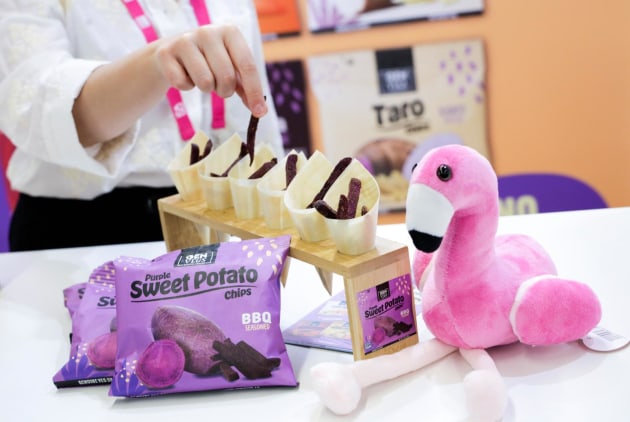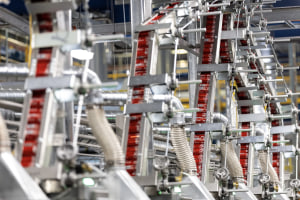The international snacks and confectionery industry came together in April at ISM 2023 in Cologne, Germany to showcase emerging trends, new technology, and the latest in flavours, colours, and textures. Kim Berry writes.
Even the sweetest sector of food manufacturing has been impacted by global forces, economic and geopolitical. It caused ISM to delay its event in January and run at the same time as ProSweets Cologne – the international supplier fair for the sweets and snacks industry – with 1300 exhibitors from 70 countries at ISM and 117 exhibitors from 23 countries for ProSweets.

Ai Group Confectionery Sector head, Tim Piper, spoke to Food & Drink Business from the exhibition floor.
“Interestingly there are not as many of the larger companies exhibiting. Instead, lots of smaller and newer businesses here and finding it valuable,” Piper says.
International market leaders and SMEs were represented across the different product segments. As well as the traditional groups – sweets and snack items ranging from chocolate and confectionery to ice cream – this year ISM also showcased segments that focused on snacking, to-go items, breakfast, and gourmet offerings.
Better-for-you boom
Piper says a pervasive trend is towards better-for-you, healthy options. “It is especially prevalent in new and emerging companies, which are using it as a marketing tool like we haven’t seen before.
“It is the virtuous circle and mirrors the broader change in consumers’ behaviour towards healthy and natural ingredients for the feel-good factor. It means confectioners are becoming more innovative when it comes to flavours and form with their products.”
ISM said that with more and more consumers placing importance on healthy and natural ingredients, manufacturers in some countries are responding with products like fruit gums made from vitamin C and zinc. Vitamin and mineral claims are not permitted on confectionery in Australia.
Plant-based products and ingredients are still booming, which is reflected by creative ideas for enriching foodstuffs with fibres. Vegetable bars with parsnips or jackfruit crisps are just two examples.
Similarly, natural sweets and snacks are also in demand because consumers consider them better-for-you options.
This doesn’t mean limited to conventional flavours as the ongoing growth and focus on more unusual flavour combinations shows. Examples at ISM were Smoky Tandoori, Bloody Mary, or Mussels in White Wine.
At ISM’s Trend Snacks Area 40 companies from 20 countries exhibited meat and fish snacks, vegan trend products, dried fruits and vegetables, fruit and vegetable crisps, and fruity drinking chocolate specialities.
Rising claims
For Piper, one of the most noticeable things this year was the use of claims on packaging.

“Making sustainability claims, or labelling your product as vegan or halal, is certainly not new, but as consumers become more informed and conscious of what they are eating, how it is made, and who made it, brands are pushing it much harder.
“The UK company Candy Kittens is exhibiting and embodies how a company can position itself with the claims it makes. Its sweets are vegan, palm oil free, carbon neutral, and made with fruit juice, natural flavours, and colours. But its target market is a younger consumer who puts a priority on such claims.”
Other segments that are growing include upcycling and manufacturers relying on sustainable usage of regional ingredients.
The chocolate section reflected the level of virtue signalling seen in other segments. Companies are relying on attributes like fair trade, low sugar, vegan, and unusual flavours. Just as Candy Kittens has created products to appeal to a younger market, chocolate makers cannot ignore environmental issues and an ethical supply chain if they want to appeal to younger consumers.
The virtuous circle continues into product packaging with the pouch’s popularity showing no sign of slowing.
“The pouch is still prevalent and gives manufacturers a way to attract new customers. The product’s recipe might not have changed so the pouch gives them a new vehicle to market the item.
“Something else we’re seeing is packaging that gives the consumer options – one of the interesting packaging examples I’ve seen was for a chocolate bar. Inside the package there were different sizes of the bar, giving the consumer a choice on how much they wanted,” Piper said.
Sweet standouts: Top 3 Innovations of ISM 2023
This year’s top innovative confectioners were judged on experimentation with new ingredients, textures, and aromas that gave consumers new taste experiences. And because of innovative production processes and environmentally friendly packaging, a product’s look, health considerations, and sustainability were also considered.
The top innovators were:
First Place
Sweet Stories candy floss, Tri d´Aix, Germany. This sugar free candy floss resulted in a unanimous decision by the jury, which said it was “just like at the fair”. It has no added colours or gluten and around 90 per cent less sugar that the original.
Second Place
Brown Sugar Boba Milk Tea Mochi by CAL Marketing, Australia.
The jury praised the chilled “soft and chewy” drink as a “taste experience of the special kind” that tapped into the Japanese speciality gradually becoming a global trend.
Third Place
Purple Sweet Potato Chips BBQ, World´s Coconut Trading Sl, Spain.
Praised for its smoky taste and colourful crisps, the jury said it was an “exotic head-turner” that stood out among conventional potato chips and snacks.

ISM 2024 is returning to its usual schedule and will be held on 28-31 January 2024.
This article first appeared in the June/July edition of Food & Drink Business magazine.








